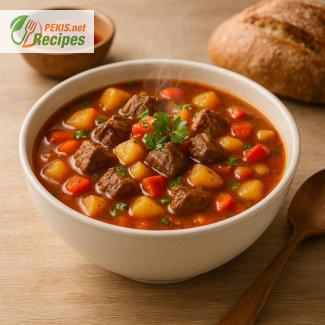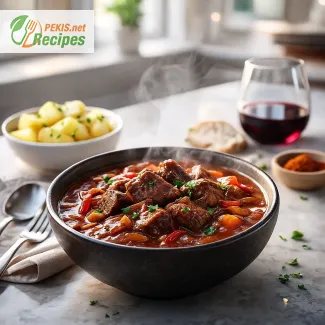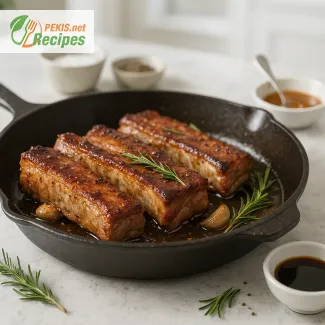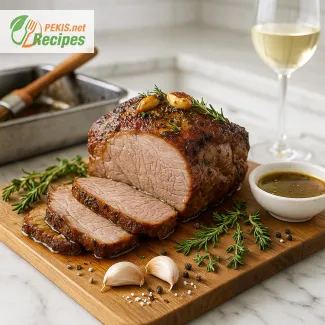
Discover the Rich Flavor of Authentic Goulash
A warming Hungarian classic that brings comfort to your table
There’s something undeniably satisfying about a hearty stew simmered to perfection, where every spoonful delivers deep, rich flavor and melt-in-your-mouth tenderness. This is exactly what the Traditional Hungarian Goulash offers — a rustic dish born from centuries of culinary tradition, perfected by generations, and now loved around the world.
Unlike many stews that use thickening agents or dairy, Hungarian goulash is distinguished by its vibrant color, paprika-infused broth, and aromatic blend of spices that develop gradually through slow cooking. It strikes the perfect balance between simplicity and depth, making it ideal for family dinners, cozy evenings, or festive gatherings where comfort food takes center stage.
Often associated with Hungarian shepherds, goulash (from the word gulyás) was originally a meat dish cooked over open fire, designed to nourish and warm during long days on the plains. Over time, it has evolved into a cherished national dish of Hungary, celebrated not just for its rustic origins, but for the way it elevates simple ingredients into something deeply flavorful.
Today, the dish has made its way into homes and restaurants across the globe — not only in Central Europe but also in Western countries where people have embraced its rich aroma and unmistakable paprika essence. It’s no surprise that "goulash recipe" continues to be one of the most searched comfort meals in the colder months.
The soul of goulash lies in its signature spice: Hungarian sweet paprika, a bold red powder made from dried and ground peppers. This ingredient doesn’t just add color — it’s essential to the earthy-sweet character of the dish. Combined with succulent beef, onions, garlic, and a touch of caraway, the result is a stew that’s at once robust and delicate, deeply warming yet not heavy.
What also makes Hungarian goulash stand out is its brothy texture. Unlike thicker stews, it remains somewhere between a soup and a ragout, perfect for ladling over buttery mashed potatoes, fresh bread dumplings, or simply enjoyed as-is, with a slice of crusty bread on the side to soak up the flavorful juices.
Cooking this dish at home invites a connection with an old-world tradition — it’s a dish that rewards patience and care. As it simmers slowly, the flavors deepen and the beef becomes increasingly tender, creating that unforgettable mouthfeel that defines comfort food.
This recipe celebrates authenticity while still being accessible to the modern kitchen. It doesn’t rely on shortcuts or packaged sauces — instead, it guides you through a step-by-step process that lets each ingredient shine. Whether you’re a seasoned cook or just beginning your culinary journey, preparing a classic Hungarian goulash is a rewarding experience that pays off in every bite.
And perhaps best of all, it’s incredibly versatile. You can serve it as a main course, prepare it in advance for busy weekdays, or freeze leftovers for later. The flavors only improve with time, making it one of those rare dishes that’s even better the next day.
So if you're looking to recreate a traditional meal with deep flavor, rich history, and timeless appeal, this Hungarian goulash is exactly what your table needs. Prepare to fill your home with the mouthwatering aroma of paprika, garlic, and beef — a combination that signals something truly special is cooking.
- Prepare the ingredients: Cut the beef into bite-sized cubes. Finely chop the onions and garlic. Slice the carrots and parsnips. Dice the bell pepper and potatoes.
- Sauté the onions: In a large pot, heat the vegetable oil (30 ml / 2 tbsp) over medium heat. Add the onions (300 g / 2 cups) and sauté until golden and soft, about 8–10 minutes.
- Add garlic and spices: Stir in the chopped garlic, sweet Hungarian paprika (30 g / 2 tbsp), and caraway seeds (5 g / 1 tsp). Cook for 1–2 minutes, making sure the paprika doesn’t burn.
- Brown the beef: Add the beef cubes and sear them on all sides until they are browned, about 5–7 minutes.
- Add vegetables and tomato paste: Stir in the carrots, parsnips, bell pepper, and tomato paste (30 g / 2 tbsp). Cook for another 5 minutes to allow the flavors to meld.
- Pour in liquids: Add the beef broth (1 liter / 4 cups) and water (500 ml / 2 cups). Toss in the bay leaves and season with salt and pepper. Bring to a boil.
- Simmer the goulash: Reduce the heat to low, cover the pot partially, and let it simmer for about 60 minutes or until the beef is tender.
- Add potatoes: Stir in the diced potatoes and cook for another 30–35 minutes, until the potatoes are soft and the broth has slightly thickened.
- Finish and serve: Remove the bay leaves. Adjust seasoning with salt and pepper if needed. Sprinkle chopped fresh parsley before serving. Serve hot, optionally with rustic bread or dumplings.
Elevating the Classic Goulash: Creative Twists for a Flavorful Experience
Enhance taste, texture, and health with modern yet authentic improvements
While the traditional Hungarian goulash stands on its own as a time-honored masterpiece, there's always room to add a personal touch or refine the process to better suit today’s kitchens, palates, and dietary needs. Whether you’re looking to deepen the flavor, make the dish healthier, or correct common missteps, small adjustments can lead to significant improvements. Here's how to take your homemade goulash to the next level.
Additions that amplify depth and complexity
One of the easiest ways to enhance your goulash is by introducing ingredients that intensify umami and aroma. Consider adding a splash of dry red wine during the sautéing of onions and beef. It not only adds richness but also balances the sweetness of the paprika with acidity. The wine reduces as it cooks, leaving behind subtle layers of flavor that elevate the entire dish.
For even greater depth, a tablespoon of Worcestershire sauce or soy sauce can be stirred into the broth. These ingredients are packed with glutamates, which increase umami and create a more savory mouthfeel without overpowering the traditional notes.
Incorporating roasted red peppers (pureed into the broth) adds sweetness and smokiness, intensifying the stew’s profile. Some home cooks also use a pinch of smoked paprika alongside the sweet variety to give the dish a gentle, woodsy character without deviating too far from authenticity.
Improving texture and consistency
If your goulash feels too thin or watery, consider blending a portion of the finished vegetables into the broth before adding the potatoes. This natural thickening technique keeps the dish gluten-free while enhancing flavor.
Alternatively, for a heartier consistency, add a few tablespoons of pearl barley or cooked lentils during the final simmer. They absorb the liquid and release starches that naturally thicken the stew while boosting the nutritional profile with fiber and protein.
Homemade vs. store-bought: Why from-scratch always wins
Using fresh, high-quality ingredients is the cornerstone of superior goulash. Store-bought options or ready-made stews often rely on preservatives, excess sodium, and artificial thickeners that dull the natural flavors of beef, vegetables, and paprika.
When you prepare goulash at home, you control the cooking time, seasoning, and ingredients, allowing for precise balance and customization. Homemade beef broth or bone broth, for example, offers collagen and minerals that not only enhance flavor but provide nutritional value unmatched by powdered or canned versions.
Moreover, preparing the dish from scratch encourages a deeper appreciation for its origins, while allowing room for innovation that suits your taste and lifestyle.
Common mistakes and how to avoid them
Overcooking the beef is one of the most frequent errors, leading to dry, stringy meat instead of the desired fork-tender texture. To avoid this, make sure the stew simmers gently and steadily, never at a boil. Using cuts like beef chuck is ideal, as its marbled fat breaks down slowly into tender, juicy morsels.
Another common mistake is burning the paprika. Since it can turn bitter if cooked at high temperatures, always remove the pot from direct heat before stirring in the paprika, then resume cooking once it's been fully incorporated with the fat and onions.
Too much tomato paste can also throw off the flavor balance. While a small amount adds umami and acidity, overuse can dominate the dish and mute the paprika. If you enjoy tomato richness, use fresh tomatoes or roasted tomato puree in moderation.
Healthier alternatives without losing authenticity
For a lighter version, swap the beef for turkey thigh meat or plant-based meat alternatives. While these won't deliver the exact same flavor as slow-cooked beef, they can still absorb the stew’s robust spices and offer satisfying texture. When using plant-based options, increase the amount of umami-rich vegetables like mushrooms or eggplant.
To reduce saturated fat, sauté onions in olive oil instead of vegetable oil or beef fat, and trim excess fat from the meat before cooking. You can also use low-sodium broth and reduce added salt, balancing the flavors with herbs like thyme, marjoram, or bay leaf.
If you’re watching carbohydrates, reduce the amount of potatoes or replace them with cauliflower florets. Cauliflower absorbs the broth and takes on the rich colors of the stew while lowering the glycemic index of the dish.
Flavor boosters from fresh herbs and spices
While goulash traditionally relies on paprika and caraway, adding herbs like fresh thyme, parsley, or a bay leaf bouquet during the simmering process brings added aromatic complexity. Always add fresh herbs toward the end to preserve their fragrance.
If you prefer a touch of heat, a pinch of cayenne pepper or a small chili pepper can bring just enough spice to excite the palate without transforming the dish into a hot stew.
To round out the flavor at the end, consider adding a teaspoon of apple cider vinegar or lemon juice. The acidity brightens the dish, especially after a long simmer, and balances the richness of the meat.
Batch cooking and flavor development
One of the unique qualities of goulash is that its flavor improves over time. Letting the stew sit for a few hours or even overnight allows the ingredients to marry and deepen. Batch cooking not only saves time but also ensures you enjoy the dish at its best the next day.
When storing leftovers, keep them in an airtight glass container and reheat slowly to preserve texture and aroma. You can also freeze portions for up to three months, ensuring you always have a comforting meal ready when needed.
Elevating tradition
Enhancing your goulash doesn’t mean abandoning its origins — it’s about finding harmony between tradition and innovation. Whether you add a splash of wine, opt for a leaner protein, or simply simmer with more intention, each tweak helps create a more personal and deeply enjoyable version of this iconic Hungarian stew.
- This recipe does not contain gluten in its original form, but cross-contamination is possible if served with bread.
- No dairy, eggs, nuts, or soy are used.
- If allergic to caraway, omit it and add a pinch of cumin for flavor depth.
- For a gluten-free meal, serve without bread or with gluten-free bread.
- Vitamin A: 5100 IU – contributes to eye health and immune support
- Vitamin C: 40 mg – supports collagen production and iron absorption
- Vitamin B12: 2.1 µg – essential for red blood cell formation
- Iron: 4.2 mg – important for oxygen transport in the blood
- Potassium: 890 mg – helps regulate blood pressure and muscle function
- Zinc: 6 mg – supports immune system and wound healing
- Lycopene (from tomato paste): 4 mg – protects against oxidative stress and supports heart health
- Beta-carotene (from carrots): 3.5 mg – boosts skin and vision health
- Flavonoids (from paprika and parsley): moderate levels – help reduce inflammation and may lower risk of chronic diseases





